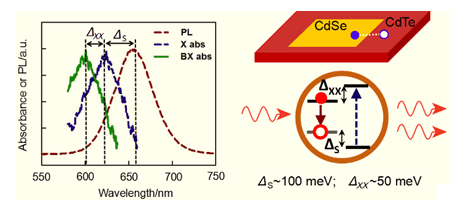| [1] Klimov, V. I.; Mikhailovsky, A. A.; Xu, S.; Malko, A.; Hol-lingsworth, J. A.; Leatherdale, C. A.; Eisler, H. J.; Bawendi, M. G. Science 2000, 290, 314.
[2] Guo, Y.; Hu, Y.; Deng, Z. T. Chin. J. Chem. 2016, 34, 259.
[3] Deng, Z. T.; Lie, F. L.; Shen, S. Y.; Ghosh, I.; Mansuripur, M.; Muscat, A. J. Langmuir 2012, 25, 434.
[4] Deng, Z. T.; Samanta, A.; Nangreave, J.; Yao, H.; Liu, Y. J. Am. Chem. Soc. 2012, 134, 17424.
[5] Markus, A.; Chen, J. X.; Paranthoen, C.; Fiore, A. Appl. Phys. Lett. 2003, 82, 1818.
[6] Garcia-Santamaria, F.; Chen, Y. F.; Vela, J.; Schaller, R. D.; Hollingsworth, J. A.; Klimov, V. I. Nano Lett. 2009, 9, 3482.
[7] Dang, C.; Lee, J.; Breen, C.; Steckel, J. S.; Coe-Sullivan, S.; Nurmikko, A. Nat. Nanotechnol. 2012, 7, 335.
[8] Kazes, M.; Lewis, D. Y.; Ebenstein, Y.; Mokari, T.; Banin, U. Adv. Mater. 2002, 14, 317.
[9] Zavelanirossi, M.; Lupo, M. G.; Krahne, R.; Manna, L.; Lanzani, G. Nanoscale 2010, 2, 931.
[10] Saba, M.; Minniberger, S.; Quochi, F.; Roither, J.; Marceddu, M.; Gocalinska, A.; Kovalenko, M. V.; Talapin, D. V.; Heiss, W.; Mura, A. Adv. Mater. 2009, 21, 4942.
[11] Okazaki, K.; Nakamura, D.; Higashihata, M.; Iyamperumal, P.; Okada, T. Opt. Express. 2011, 19, 20389.
[12] Li, Q. Y.; Xu, Z. H.; Mcbride, J. R.; Lian, T. ACS Nano 2017, 11, 2545.
[13] Grim, J. Q.; Christodoulou, S.; Di Stasio, F.; Krahne, R.; Cingolani, R.; Manna, L.; Moreels, I. Nat. Nanotechnol. 2014, 9, 891.
[14] Wang, Z. G. Physics 2000, 11, 643. (王占国, 物理, 2000, 11, 643.)
[15] Yakunin, S.; Protesescu, L.; Krieg, F.; Bodnarchuk, M. I.; Nedelcu, G.; Humer, M.; De Luca, G.; Fiebig, M.; Heiss, W.; Kovalenko, M. V. Nat. Commun. 2015, 8056.
[16] Park, Y.-S.; Bae, W. K.; Padilha, L. A.; Pietryga, J. M.; Klimov, V. I. Nano Lett. 2014, 14, 396.
[17] Klimov, V. I.; Ivanov, S. A.; Nanda, J.; Achermann, M.; Bezel, I.; McGuire, J. A.; Piryatinski, A. Nature 2007, 447, 441.
[18] Ithurria, S.; Dubertret, B. J. Am. Chem. Soc. 2008, 130, 16504.
[19] Ithurria, S.; Bousquet, G.; Dubertret, B. J. Am. Chem. Soc. 2011, 133, 3070.
[20] Ithurria, S.; Tessier, M. D.; Mahler, B.; Lobo, R. P. S. M.; Dubertret, B.; Efros, A. L. Nat. Mater. 2011, 10, 936.
[21] Joo, J.; Son, J. S.; Kwon, S. G.; Yu, J. H.; Hyeon, T. J. Am. Chem. Soc. 2006, 128, 5632.
[22] Arakawa, Y.; Sakaki, H. Appl. Phys. Lett. 1982, 40, 939.
[23] She, C.; Fedin, I.; Dolzhnikov, D. S.; Demortiere, A.; Schaller, R. D.; Pelton, M.; Talapin, D. V. Nano Lett. 2014, 14, 2772.
[24] Wu, K.; Li, Q. Y.; Jia, Y. Y.; McBride, J. R.; Xie, Z. X.; Lian, T. ACS Nano 2015, 9, 961.
[25] Htoon, H.; Hollingworth, J.; Malko, A.; Dickerson, R.; Klimov, V. I. Appl. Phys. Lett. 2003, 82, 4776.
[26] Fan, F.; Voznyy, O.; Sabatini, R. P.; Bicanic, K. T.; Adachi, M. M.; McBride, J. R.; Reid, K. R.; Park, Y.-S.; Li, X.; Jain, A.; Quintero-Bermudez, R.; Saravanapavanantham, M.; Liu, M.; Korkusinski, M.; Hawrylak, P.; Klimov, V. I.; Rosenthal, S. J.; Hoogland, S.; Sargent, E. H. Nature 2017, 544, 75. |
